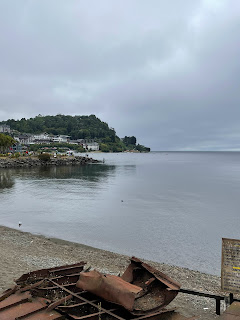I remember things better when I write them down and in the last several days from my various drivers and guides, I’ve learned things about this country that I don’t want to forget. So here goes. This stuff may be of no interest to anyone else, so don’t spend the time reading if that’s the case.
I’ve learned that the average Chilean earns the equivalent of about $800 per month. Everyone has to pay at least 7% into the national health system. I was told that the national health system is good if you are suffering from something on a list of catastrophic diseases the government has developed. If you have one of those, your care, medicine etc. are covered completely. If whatever ails you isn’t on that list, you’re in trouble. There are long waiting times to be seen or treated. If you want to participate in a private health system, it costs 23% more of your income, but there are still difficulties because many of the doctors work for both systems.
I was told by several of the Chileans I encountered that the public education system is pretty bad, so many families try to send their children to private schools. A mediocre, but still superior to a public one, school costs around $600 per month. Given the average income I can see a family would be stretching to afford this. Chile also has a subsidized housing system. For lower income people the government will subsidize housing costs anywhere from 10 to 90 percent. While that sounds pretty good the average size of a house may be only 45 meters; that’s a little over 400 square feet. The average Chilean family has 2.8 children. I can’t help thinking that makes for tight quarters.
The housing situation became a problem when Covid arrived. In Chile the country was locked down for nearly 18 months. According to my guide yesterday lockdown in Chile meant that people were allowed to go out of their homes for two hours a day every day to do exercise of some kind, masked and not in groups. They were allowed out for two hours per week to shop for food and other necessaries. Aside from that, if they were caught outside they were subject to fines and/or arrest. Ingrid told me that the enforced lockdowns in small spaces created a lot of domestic difficulties among families. The incidence of spousal and child abuse increased dramatically apparently.
When Al and I visited Santiago 18 years ago, we rode the Metro and wandered around downtown in the district where the main square, cathedral, museums and central market are and felt totally safe and most everywhere was spotless. All my guides on this trip told me that in the cities it's dirty and there are gangs of "delinquents," as they put it, who prey on everyone, not just tourists. They all attributed this to an exploding immigrant population. Evidently Chile has lots of people moving here from Venezuela and other South American countries suffering political unrest
Okay, those are some of the things I was told and want to remember. They actually make me happy that I’m a citizen of the USA. Oh, one more thing. The current president of Chile, Gabriel Boric, is only in his mid-30’s, has never had a job outside of government, is extremely far left ideologically as several people told me, and as Ingrid (my guide in Puerto Montt) said “he has no idea what he’s doing.” In Chile the president serves for 4 years and can’t run again immediately. She said he has two more years to go before, as she put it, “the next president will have to figure out how to straighten up the mess.” Some of this sounds strangely familiar.





























